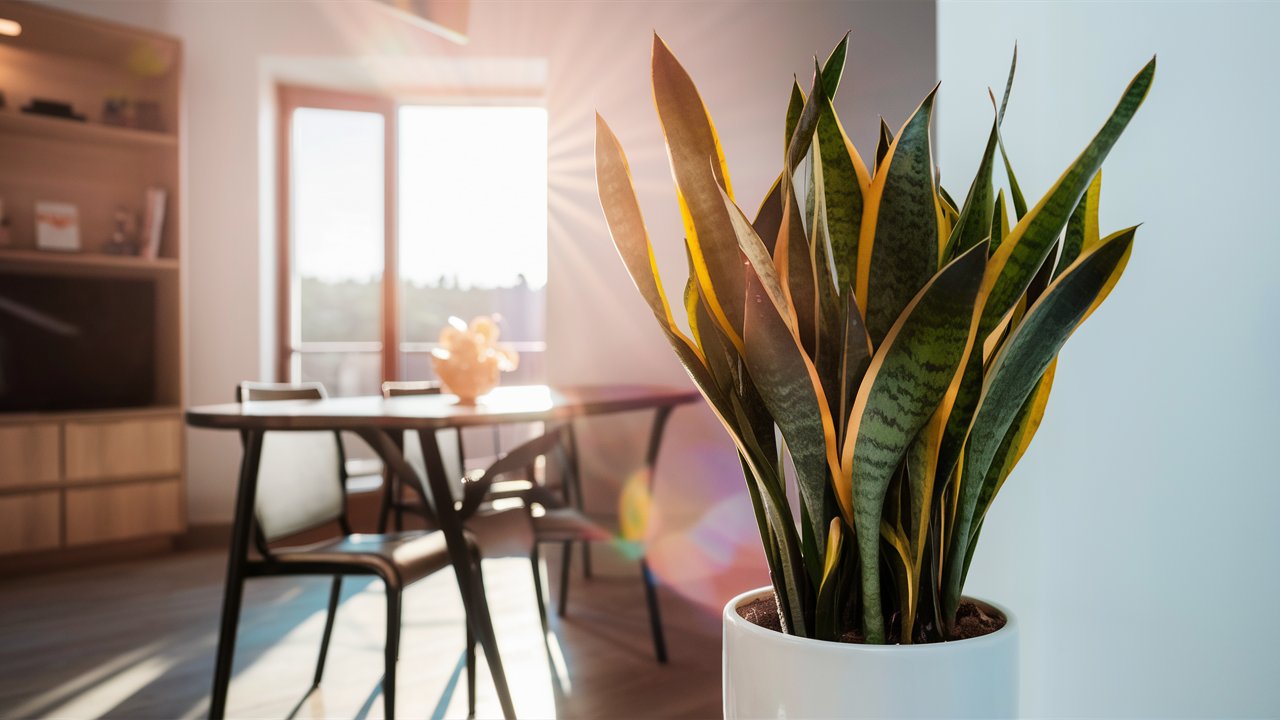Disclosure: Some links on this site are affiliate links. As Amazon Associates, we earn from qualifying purchases (at no cost to you).
Ever wondered why snake plants are all the rage in home decor? Let’s dive into the world of these green beauties and discover why they’re a must-have for your living space.
7 Main Benefits Of Snake Plants
1. Air Purification

Snake plants are like little green air purifiers. They absorb toxins like formaldehyde, xylene, toluene, and benzene from the air.
Imagine having your personal air cleaner that works 24/7. In NASA’s Clean Air Study, snake plants were found to be effective in improving indoor air quality.
Say goodbye to indoor pollution and hello to fresh, clean air!
2. Low Maintenance

Got a brown thumb? No worries.
Snake plants are among the toughest houseplants you can find. They thrive on neglect. Forget to water them for weeks? They won’t hold it against you.
These resilient plants can survive in low light conditions and irregular watering schedules, making them perfect for busy or forgetful folks.
3. Improves Mood

Surrounding yourself with greenery can lift your spirits. Snake plants add a touch of nature to your home, creating a more pleasant and tranquil atmosphere.
Studies have shown that having plants around can reduce stress, anxiety, and even boost your mood. It’s like having a silent, leafy therapist in your living room.
4. Boosts Humidity

Dry air in your home? Snake plants release moisture into the air through a process called transpiration.
This helps to maintain the right humidity level in your living space, which can be particularly beneficial during dry winter months. Proper humidity levels can prevent dry skin, sore throats, and respiratory issues.
5. Enhances Home Décor

Snake plants, with their tall, upright leaves and striking patterns, are a great addition to any home décor. They come in various sizes and colors, allowing you to choose the perfect plant to complement your interior design.
Whether you prefer a modern, minimalist look or a more eclectic style, there’s a snake plant that fits your aesthetic.
6. Improves Sleep Quality

Placing a snake plant in your bedroom can improve your sleep quality. This plant converts carbon dioxide into oxygen at night, unlike most plants that do this during the day.
More oxygen means a better sleeping environment. Plus, the calming presence of the plant can help you relax and unwind before bedtime.
7. Spiritual and Health Benefits

Many believe that snake plants have spiritual benefits. In feng shui, they are considered to bring protective energy and ward off negative vibes.
Health-wise, they can help alleviate headaches, eye irritations, and breathing problems by filtering harmful substances from the air. Imagine a plant that not only beautifies your space but also promotes well-being.
How to Care for Snake Plants
Caring for snake plants is a breeze, even for beginners. Here are some simple tips to keep your plant healthy and thriving:
1. Light: Snake plants are highly adaptable. They can tolerate low light levels but prefer indirect sunlight. A spot near a window with filtered light is ideal.
2. Watering: Overwatering is the most common way to kill a snake plant. Water your plant every 2-6 weeks, depending on the season and humidity. Allow the soil to dry out completely between waterings.
3. Soil: Snake plants prefer well-draining soil. A cactus or succulent mix works great. Avoid using heavy, moisture-retentive soils.
4. Temperature: These plants are comfortable in a wide range of temperatures, but they thrive best in 60-85°F (15-29°C). Protect them from frost, as they are not frost-tolerant.
5. Fertilizing: Snake plants don’t need much fertilizer. Feed them with a balanced, all-purpose fertilizer during the growing season (spring and summer) once a month.
6. Repotting: Snake plants grow slowly and don’t require frequent repotting. Repot them every 2-3 years or when the roots start to outgrow the pot.
FAQs About Snake Plants
Q: Are snake plants toxic to pets?
A: Yes, snake plants are mildly toxic if ingested by pets. Keep them out of reach of curious cats and dogs.
Q: Can snake plants survive in low light?
A: Absolutely! Snake plants are highly adaptable and can thrive in low light conditions, though they grow faster in brighter light.
Q: How often should I water my snake plant?
A: Water every 2-6 weeks, allowing the soil to dry out completely between waterings. Overwatering can lead to root rot.
Q: Why are the leaves of my snake plant turning yellow?
A: Yellow leaves can indicate overwatering or poor drainage. Ensure the soil is well-draining and allow it to dry out between waterings.
Q: Can snake plants help with allergies?
A: Yes, by improving indoor air quality and adding moisture to the air, snake plants can help reduce allergens and relieve allergy symptoms.
Final Thoughts
Snake plants are more than just a trendy addition to your home decor. They offer numerous benefits, from improving air quality and boosting your mood to enhancing your home’s aesthetic appeal. Plus, they are incredibly easy to care for, making them perfect for both novice and experienced plant enthusiasts. Whether you’re looking to purify the air, add a touch of greenery, or simply enjoy the spiritual and health benefits, snake plants are a fantastic choice.
Bring one (or a few) into your home and enjoy all the perks these hardy, beautiful plants have to offer. With their low-maintenance nature and myriad benefits, it’s easy to see why snake plants are a popular choice for households everywhere. So go ahead, green up your space with a snake plant today!


